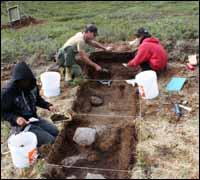 Mikak's House Black Island Site. |
Amelia Fay, PhD, MUN 2016
(Memorial University SSHRC Distinction Award)
My PhD research has two primary objectives: 1) to examine the effects of colonialism on 18th century Inuit socio-economic relationships through the excavation of a dwelling on Black Island, Labrador; 2) to explore gender relations, in particular how the lives of Inuit women were affected by increased European interaction and the shift from a predominately subsistence-based to a mixed hunting/trading economy, by comparing data from Black Island to similar data from contact period collections. My comparison data is drawn from other Inuit sites that have been historically documented as having an influential presence during their occupation, such as a shaman or “big-man” trader, as well sites that have not been linked to a prominent historical figure and that might represent a “typical” 18th century Inuit house.
The fieldwork component of this project focused on the excavation of an 18th century sod house on Black Island, Labrador. According to a 1776 Moravian census an Inuit woman named Mikak lived in this dwelling on Black Island. Her life story is significant as she was heavily involved in the coastal baleen trade network and very influential in the granting of British land to the Moravian missionaries who established their first mission in Nain in 1771. The unique historical and archaeological value of her home on Black Island make it the ideal location to evaluate the colonial effects on Inuit socio-economic and gender relationships during the 18th century.
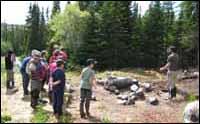 Snook's Cove Archaeology Project. |
Brian Pritchard, PhD Candidate, MUN
(Joseph Armand Bombardier CGS Doctoral Scholarship winner)
There are two primary objectives of my doctoral research 1) to develop a typology of sod-house architecture relating to the ethnicity, or identity, of the European, Inuit, or Métis inhabitants, and 2) to better understand indigenous cultural developments and the nature of relations between European settlers and indigenous people during a period of time (A.D. 1800-1950) that has been neglected in Labrador studies. Owing to problems with determining unequivocally the ethnic, or cultural, association of recent phase sod-houses, past research has focused on early and communal-house phase settlements. Accordingly, this research will expand our understanding of European-indigenous interaction and cultural developments into the 20th century.
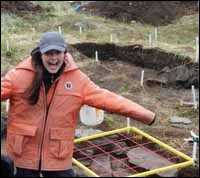 Laura Kelvin at Indian Harbour. |
Laura Kelvin, MA, MUN 2011
(Joseph Armand Bombardier CGS Master's Scholarship winner)
During the late eighteenth and nineteenth centuries the Inuit, European and Inuit-Metis in southern Labrador constructed and lived in similar sod dwellings. On the surface, the archaeological remains of these dwellings are almost identical, making it difficult to target a specific culture to research. A minimal number of European and Inuit sod dwellings have been excavated and a comparison of the construction of these structures and their archaeological assemblages has already been somewhat established. To date, only one Inuit-Metis sod dwelling has been excavated. For my MA thesis research I interviewed residents of the Sandwich Bay area of southern Labrador in order to determine the locations of Inuit-Metis archaeological sites. The sites found during my fieldwork were compared to previously excavated Inuit and European sites to see how they differed. They were also compared to an Inuit-Metis sod dwelling already excavated, to determine if there is a recognizable trend for Inuit-Metis sites.
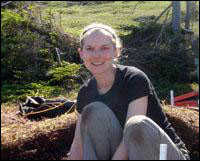 Phoebe Murphy at the Indian Harbour Site. |
Phoebe Murphy, MA, MUN 2011
(Joseph Armand Bombardier CGS Master's Scholarship winner)
My thesis research was based on an Inuit sod house located in Indian Harbour, southern Labrador. The house was excavated during the summer of 2010 and material culture and architectural style indicate an 18th century occupation. Archaeological investigation of southern Labrador Inuit during this period is almost non-existent, although sites that pre-date and post-date this period have been examined in some detail. During the 18th century in northern Labrador and parts of Greenland, the Inuit adopted large multi-family houses in place of single family dwellings and this has been termed the 'communal house phase'. A number of theories have been posited for the development of communal houses in Labrador, one of the most dominant is centered on the rise of certain Inuit individuals as influential middleman traders acting as intermediaries between the Europeans and Inuit. My thesis research explored the nature and effects of contact in the southern region during the 18th century when the European presence was intensifying and Inuit architectural style was transforming. My research has contributed to the refinement of the Inuit settlement chronology while addressing the nature of communal houses in Labrador, including the purpose and significance of multi-family structures adopted ubiquitously across Labrador in a relatively short time span.
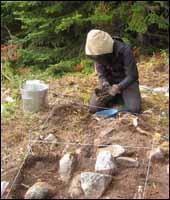 Snooks Cove Site. |
Eliza Brandy, MA, MUN 2013
(Joseph Armand Bombardier CGS Master's Scholarship winner)
My MA thesis fieldwork involved the excavation of two historic Inuit houses at the site of Snooks Cove in Hamilton Inlet, Labrador. This site was occupied by the Inuit from the pre-contact period through the 20th century, and became an important link in the trading network of the 19th century. Until recently, this later historic period of European contact has received little attention from archaeology, largely due to the difficulty of archaeologically determining the ethnicity of households in southern and central Labrador, since the Inuit, Métis, and European settlers all occupied very similar sod dwellings. During this period the Inuit experienced great sociocultural shifts resulting from increased contact with European hunters and traders. My thesis will focus on the analysis of the faunal remains recovered at Snooks Cove and will contribute to the ongoing research in Labrador by developing criteria for archaeologically differentiating Inuit and European ethnicity based on evidence of subsistence and animal use patterns. In this way, an ethnic signature can be determined for the historic Inuit and applied to the archaeological identification of other Inuit houses in Labrador.
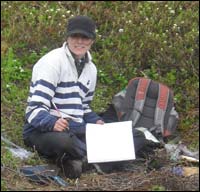 Kara Wolfe |
Kara Wolfe, MA, MUN 2013
(Joseph Armand Bombardier CGS Master's Scholarship winner)
My MA research is focussed on the larger picture of culture contact in Newfoundland's Northern Peninsula and the southern coast of Labrador. To do this I will use both the written record and collections from both Aboriginal and European sites. My collections research is focussed on two European goods that were readily adopted by the Inuit, ceramics and iron nails. These collections include Inuit sod houses that were tested by Dr. Marianne Stopp and two sites that were excavated by Dr. Stopp and Dr. Lisa Rankin as part of the CURA project, as well as two European sites, Lodge 1 along the Charles River and the French fishing station of Dos de Cheval. While ceramics have been studied quite a bit in the past nails have not been studied in detail. I will be examining collections from several different sites and several different time periods to gain a wider understanding of the broad trends of culture contact in this area. I hope that by studying these everyday items I will be able to say something about the trade networks that existed between both the Inuit and the Europeans, as well as, between the Inuit themselves.
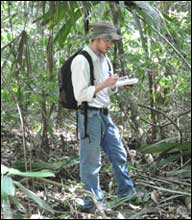 Will McGrath |
William McGrath, MPhil, UNB 2016
My graduate work is through the Interdisciplinary Studies program at the University of New Brunswick, where I am enrolled as an MPhil candidate. In my program, I aim to combine the fields of Anthropology, Education and Information Technology. The purpose of my research is to explore the possibilities for presenting materials produced by the “Understanding The Past to Build The Future” project in an educational format for school use. To do this I will be collaborating with educators in south eastern Labrador in order to help develop a suitable method for transmitting these materials. The focus of my research is to create a virtual environment within which learners will be able to explore and interact with manifestations of the materials that emerge from this project.
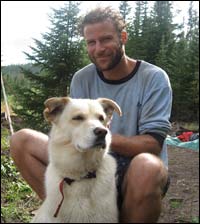 Andrew Collins |
Andrew Collins, MA Candidate, MUN
My MA thesis will be directed toward the acquisition, movement and use of European ceramic goods by the Inuit on the Labrador coast during the 17th and 18th centuries. In particular, I aim to analyze and compare the ceramic assemblages from Sandwich Bay, on the South Coast, to assemblages from Central and Northern Labrador such as those at Eskimo Island. By doing this, I hope to gain a better understanding of how Labrador Inuit were obtaining and distributing European goods, what role the Sandwich Bay Inuit played in this exchange, and also to explore the broader social implications this information may have for Labrador Inuit.
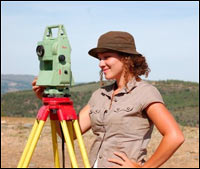 Michelle Davies |
Michelle Davies, MA, MUN 2014
(ISER MA Fellowship winner)
My MA research will involve an analysis of the spatial distribution of gendered artefacts recovered from Labrador Inuit winter houses, which were occupied during the 'communal house phase' of the 18th century. Though similar in style, there are regional differences between communal houses that suggest that they may have served different purposes. To date, the communal houses excavated in southern Labrador are among the largest houses but appear to have been occupied briefly and contained minimal artefact assemblages. This stands in contrast to Inuit communal houses in northern Labrador which were often re-occupied and contain substantial artefact assemblages. By comparing gender associated artefacts from communal houses from northern, central and southern Labrador I hope to help shed light on the household activities of men and women and determine if the houses were being used in similar or different ways in the different regions.
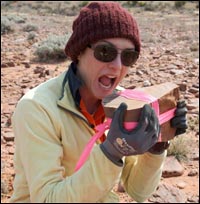 Paulina Dobrota |
Paulina Dobrota, MA, MUN 2014
(Joseph Armand Bombardier CGS Master's Scholarship winner)
My research focuses on the relationship between human groups, cultural practices and the environment in which they take place, with an additional focus on developing ways of interacting with the archaeological record that highlight these relationships. For my MA thesis, I am using three soil analysis methods, paleoethnobotanical floatation, geochemistry and micromorphology, to study tent ring floors from the summer component of Huntingdon Island 5 (FkBg-3), in Sandwich Bay. This research aims to reconstruct the taskscape associated with this Inuit summer camp; contrast data obtained from tent rings with the sizable amount of information already available from the winter sod houses previously excavated on the island; and develop a method geared to study tent rings, outdoor sites and other types of ephemeral occupations, generally connected to the summer season in Arctic and Subarctic regions. This approach is an operationalization of the anthropological understanding of Inuit social and spiritual life as segmented by seasonal pursuits and the scheduling of resources during the annual round.
By integrating the study of plant remains with geochemistry and pedological analysis, I aimed to put together a set of methods that comprehensively engage with soil ecology. This will allow me to understand taphonomical processes that impact summer camps as well as their environmental signatures, an approach that redefines humans as active environmental agents.
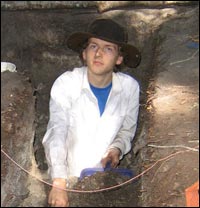 Tyrone Hamilton |
Tyrone Hamilton, MA, MUN 2015
(ISER MA Fellowship winner)
My MA research will involve a geochemical provenance analysis of iron artifacts associated with Inuit sites along the coast of Labrador. With the iron materials having been salvaged from seasonal Basque whaling stations in southern Labrador during the early contact period of the 16th century, discerning how this newly introduced source of iron was being exploited and dispersed during this time can give us insights into the significance and impact of this resource on Inuit society at this period in history. For the purposes of my project I will be using Laser Ablation-Multiple Collector-Inductively Coupled Plasma-Mass Spectrometry (LA-MC-ICP-MS) on several iron artifacts from Red Bay and early contact period Inuit sites along the coast of Labrador in order to determine the geographic extent of Basque iron in the Inuit archaeological record prior to 1600 CE.
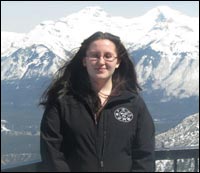 Rebecca Ralph |
Rebecca Ralph, MA, MUN 2014
(Joseph Armand Bombardier CGS Master's Scholarship winner)
My research is concerned with understanding the impact of the Anglican Church on communities in Southern Labrador. For my thesis I will analyze the impact that the religious outlook held by missionaries trained and sent by Anglican Bishop Edward Feild had on the community development of Battle Harbour and Forteau. My research which centered on the records of the Society for the Propagation of the Gospel that contain, letters from missionaries in Labrador, accounts of Bishop Edward Feild in Labrador, and instructions from the secretary of the SPG to missionaries in Labrador. By examining these records, and other scholarly literature, I hope to shed light on missionaries' life experiences in Battle Harbour and Forteau, and the people of these communities relationship with the Church of England.
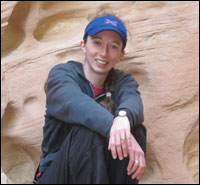 Jeralyn Bohms |
Jeralyn Bohms, MA, MUN 2015
(ISER MA Fellowship winner)
For my thesis, I will be excavating an 18th-century Inuit communal winter house at Double Mer Point in the Narrows of Hamilton Inlet, near the town of Rigolet, Labrador. Although one of the sites used by Richard Jordan to develop a timeline of Inuit occupation of Hamilton Inlet during the 1970s, only minimal excavations have been carried out at the site. Detailed investigations of the site will help to clarify this timeline, since other recent work at Eskimo Island and Snook's Cove indicates that Jordan's interpretation needs to be reevaluated. In addition, I will explore the relationship between the Inuit of Double Mer Point and the growing European population of traders and fishers in the area. I will compare Double Mer Point to other Inuit settlements in Labrador to see if the communal winter house is used in a manner similar to houses in northern Labrador, with their long-term occupation, or if it is more like an apparent southern Labrador variation, which was only occupied for a short time. In this way, Double Mer Point will provide some much-needed context for understanding the development of the communal winter house.
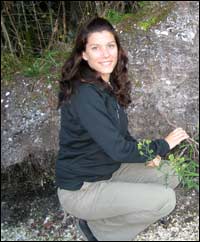 Meghan Burchell |
Meghan Burchell, PhD, McMaster 2013
(SSHRC Doctoral Fellow, Department of Anthropology)
I am currently completing my PhD in archaeology at McMaster University under the supervision of Dr. Aubrey Cannon. My dissertation, “Histories of Shellfish Harvest and Management on the Coast of British Columbia: A novel approach using high-resolution stable isotope sclerochronolog” examines resource management practices and seasonal settlement patterns on the Coast of British Columbia though the biological and chemical analyses of archaeological shells.
Using stable oxygen isotope analysis coupled with high-resolution sclerochronology, my work models patterns of local and regional paleoclimate in relationship to the intensity of local shellfish harvesting practices. This technique combines both the microgrowth formation and biology of shellfish with their geochemical signatures, specifically stable oxygen isotopes to determine a precise season of collection. My research interests are to improve seasonality estimates using shellfish at shell midden sites, hunter-gather resource conservation and management, climate change, as well as understanding how people interacted with past environments.
My research contribution to the CURA project uses the technique of high-resolution stable oxygen isotope sclerochronology to examine seasonal patterns of mussel collection from the site, FeAx-03. This seasonality data will be integrated into my dissertation, since this site provides a unique temporal scale to understand an historic era occupation – especially when compared to the shell middens from the North Pacific Coast, which span over several millennia.
The labwork for this project is completed at the Fisheries Archaeology Research Centre at McMaster University and with the assistance of Dr. Bernd R. Schöne, director of INCREMENTS Research Centre at the University of Mainz in Germany.
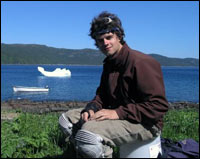 Eric Guiry |
Eric Guiry, MA, MUN 2012
(Joseph Armand Bombardier CGS Master's Scholarship winner)
I am currently completing my master's program under the supervision of Dr. Vaughan Grimes. The project is entitled Dogs as analogs in stable isotope based human paleodietary reconstructions: An assessment of the suitability of the 'Canine Surrogacy Approach' (CSA). This work explores the utility of dietary information derived from dog bone chemistry for reducing archaeologists' reliance on the destructive analysis of human remains during stable isotope based paleodietary reconstructions.
I have analyzed select dog remains from the CURA project's excavations in order to assess whether dog diets reflect inputs from human provisioning and may thus reflect human dietary behavior. This data will be integrated into my thesis as a case study for CSA suitability in the region.
The lab work for this project was completed in Memorial University's Department of Archaeology as well as the CREAIT Stable Isotope Laboratory in the Department of Earth Sciences. Additional funding has been granted by the Provincial Archaeology Office of Newfoundland as well as the Institute for Social and Economic Research.
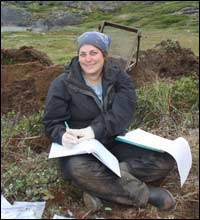 Lindsay Swinarton |
Lindsay Swinarton, PhD Candidate, Université Laval
(SSHRC Doctoral Fellow, Département d'histoire)
I am a PhD candidate in archaeology at Université Laval, studying arctic zooarchaeology under the direction of Dr. James Woollett. My dissertation, “Inuit Household Subsistence and Food Practices in 18th Century Communal Houses in Northern Labrador,” examines the economic and social implications of household life (subsistence practices and social organisation) among Inuit families sharing communal houses during the second half of the 18th century at the sites of Oakes Bay 1 (HeCg-08) and Uivak Point 1 (HjCl-09). In particular, I am interested in the social rules that governed the acquisition, use and deposition of animal bones and artefacts within a dwelling and how these may have changed amid increased interactions with Moravian missionaries and other Europeans.
My main contribution to “Understanding the Past to Build the Future” involves the analysis of the faunal assemblages collected by the researchers and students associated with the project. These faunal analyses, conducted using the reference collections at the Bioarchaeology Lab at Université Laval, provide valuable comparative material that expands our understanding of the history and variability of animal acquisition and subsistence strategies among the coastal Labrador Inuit over the last several hundred years.
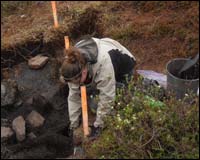 Chelsee Arbour |
Chelsee Arbour, PhD Candidate, MUN
(Joseph Armand Bombardier CGS Doctoral Scholarship winner)
I am a Ph.D. candidate in archaeology at Memorial University of Newfoundland researching the Maritime Archaic in Labrador, under the direction of Dr. Peter Whitridge. In the summer of 2010, I traveled to Labrador to participate on Dr. Marianne Stopp's (Parks Canada) excavation of an Inuit sod house dating to the late 17th – early 18th century, located on North Island in southern Labrador. A product of that field season, and my main contribution to “Understanding the Past to Build the Future”, was the making of a documentary video entitled “The Winter Dwellers”. This short film was developed to illustrate the excavation process on North Island, foster community involvement and elaborate on European-Inuit relations in southern Labrador.
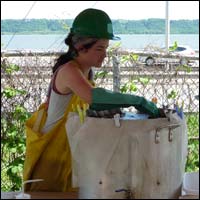 Maryse Cloutier-Gélinas |
Maryse Cloutier-Gélinas, PhD Candidate, Université Laval
(Vanier CGS Scholar, Co-founder of G.A.I.A. inc, Group for Archaeological Interpretation and Analysis)
I am a PhD candidate in geography at Université Laval, in Québec, studying the relationships
between people and places under the direction of Dr Matthew Hatvany. My PhD project “Of
Both the Sacred and the Profane: a Study on the Corporeality and Spirituality of Religieuses in
19th century French Canada” investigates the personal, and social universe of these women. I
focus on this through the examination of their perceptions of sacred and profane places (through
the way they managed and used space) that composed their environment. This project combines
the examination of archival material, spatial studies, and the analyses of preserved seeds, insect
remains, and animal bones retrieved from two 19th century convents in Québec. These are
indicators of past culinary practices, consumption habits, local salubrity, and personal hygiene, as
well as the general health status of the convent's inhabitants.
My contribution to “Understanding the Past to Build the Future” is primarily through G.A.I.A.
Inc. I have been analyzing the insect remains associated with the archaeological sites in Sandwich Bay
that Dr. Rankin and her students are excavating. This will bolster our understanding of coastal Labrador Inuit past economies, consumption habits, health, living conditions inside and outside dwellings, as well as their use of
space, and site formation processes.
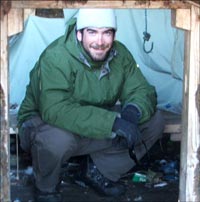 Frédéric Dussault |
Frédéric Dussault, PhD Candidate, MUN
(Joseph Armand Bombardier CGS Doctoral Scholarship winner, FQRSC Doctoral fellow and F. A. Aldrich fellowship)
I am a PhD candidate in archaeology at Memorial University of Newfoundland under the supervision of Dr. M.A.P. Renouf. My archaeological research will examine the subsistence economy and settlement patterns of the Dorset Palaeoeskimo in Newfoundland, as well as the impact of their activities on the environment. My research entails the identification of plant and plant parts such as pollen and insect remains from soils sampled from the Port au Choix National Historic Site, located in northwestern Newfoundland, and Stock Cove, in southeastern Newfoundland. I am interested in looking at these previously neglected data sets in order to find secondary economic sources of the Dorset, and, hopefully, be able to document how men, women, children and elders took part within the exploitation of those economic resources.
My contribution to the "Understanding the Past to Build the Future" project was made possible through G.A.I.A. Inc, which hired me for archaeoentoentomological analysis. The analysis, made possible by using the reference material and entomological collection of the Laboratoire d'Archéologie Environnementale at Université Laval, provided valuable information on the living conditions of the site's inhabitants, the human-made and natural environment. Furthermore, the work done for this project allowed us to research different possibilities for future work on Labrador coastal populations and can be considered pioneering work in archaeoentomology, as very little analysis have been carried on Inuit sites.